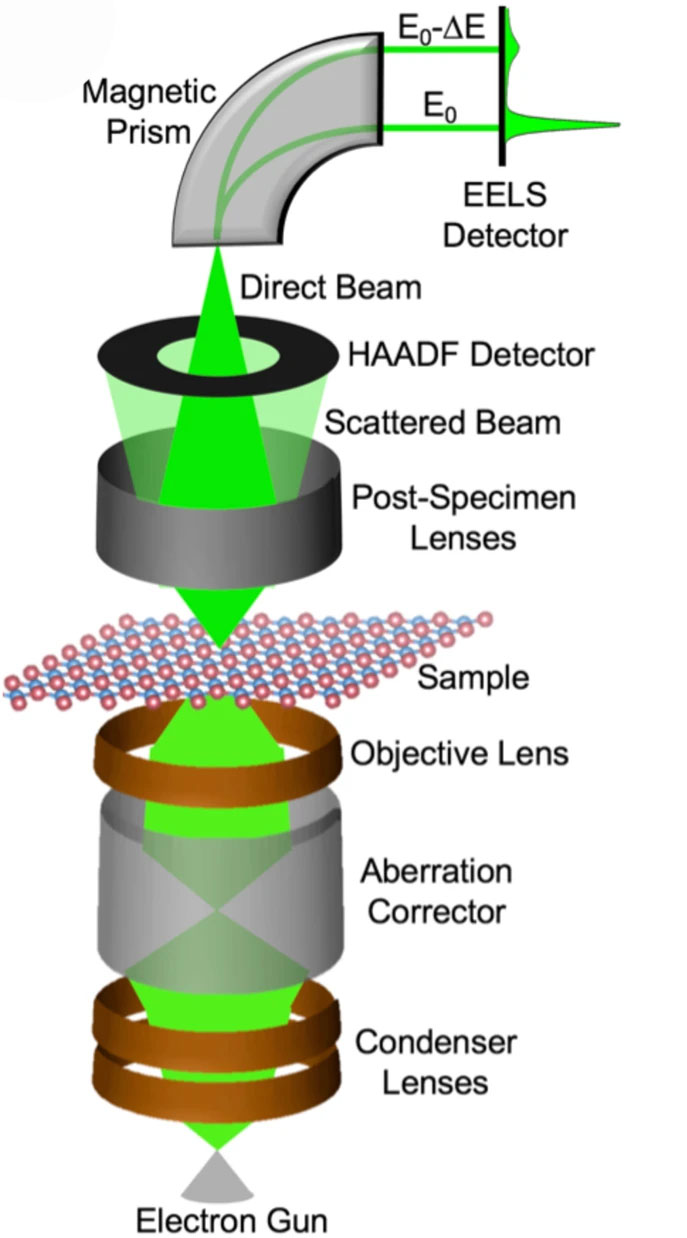Electron Energy Loss Spectroscopy (EELS): Nanoscale Material Characterization
What is Electron Energy Loss Spectroscopy?
Electron energy loss spectroscopy (EELS) is a powerful analytical technique used to study the chemical composition, electronic structure, and local bonding environment of materials at the nanoscale. It is often performed in conjunction with transmission electron microscopy (TEM), providing high spatial resolution and sensitivity to light elements.

How Does EELS Work?
In EELS, a focused beam of high-energy electrons (typically 100-300 keV) is directed at a thin sample. As the electrons pass through the sample, they interact with the atoms and electrons in the material, losing energy through various inelastic scattering processes. The transmitted electrons are then collected by a spectrometer, which measures their energy distribution.
The resulting energy loss spectrum contains information about the sample's chemical composition and electronic structure. The spectrum consists of several features:
- Zero-loss peak: Electrons that have not undergone inelastic scattering, retaining their original energy.
- Low-loss region: Energy losses up to ∼50 eV, containing information about collective excitations (plasmons) and interband transitions.
- Core-loss region: Energy losses above ∼50 eV, corresponding to ionization edges of specific elements, providing information about chemical composition and bonding.
Key Capabilities of EELS
EELS offers several unique capabilities for nanoscale material characterization:
Chemical Composition Mapping
By analyzing the core-loss region of the EELS spectrum, the presence and relative abundance of specific elements can be determined with high spatial resolution. This allows for the mapping of chemical composition at the nanoscale, providing insights into the distribution of elements within a sample.
Electronic Structure Analysis
The fine structure of the core-loss edges in the EELS spectrum contains information about the local electronic structure and bonding environment of the probed atoms. By analyzing the energy loss near-edge structure (ELNES) and the extended energy loss fine structure (EXELFS), details about the oxidation state, coordination, and local bonding can be obtained.
Plasmon Mapping
The low-loss region of the EELS spectrum is sensitive to the collective excitations of valence electrons, known as plasmons. By mapping the plasmon energy and intensity, information about the local dielectric properties and electronic structure of the sample can be obtained, providing insights into material properties such as band gaps and carrier concentrations.
Applications of EELS in Nanotechnology
EELS is widely used in nanotechnology research for the characterization of a variety of nanomaterials and nanostructures:
Nanoparticles and Nanocomposites
EELS is employed to study the chemical composition, elemental distribution, and interfacial properties of nanoparticles and nanocomposites. It provides valuable information for optimizing the synthesis and performance of these materials in various applications, such as catalysis, energy storage, and optical devices.
2D Materials
EELS is a powerful tool for investigating the properties of 2D materials, such as graphene, transition metal dichalcogenides, and hexagonal boron nitride. It can reveal the local electronic structure, defects, and edge states in these materials, which are crucial for understanding their unique properties and potential applications.
Semiconductor Nanostructures
EELS is used to characterize semiconductor nanostructures, such as quantum dots, nanowires, and thin films. It provides information about the composition, band structure, and interfacial properties of these nanostructures, which is essential for developing advanced optoelectronic and electronic devices.
Challenges and Future Perspectives
Despite its powerful capabilities, EELS also faces several challenges. One of the main limitations is the requirement for very thin samples (typically <100 nm) to ensure sufficient electron transmission and minimize multiple scattering events. Sample preparation techniques, such as focused ion beam (FIB) milling and ultramicrotomy, are crucial for obtaining high-quality EELS data.
Another challenge is the interpretation of complex EELS spectra, particularly in the case of heterogeneous or beam-sensitive materials. Advanced data processing techniques, such as multivariate analysis and machine learning, are being developed to extract meaningful information from EELS datasets.
Future developments in EELS instrumentation and data analysis are expected to further enhance its capabilities. Improvements in energy resolution, detectors, and monochromators will enable the study of even finer details in the EELS spectrum. Integration with other analytical techniques, such as energy-dispersive X-ray spectroscopy (EDS) and electron tomography, will provide a more comprehensive understanding of nanomaterials.
Further Reading
Reports on Progress in Physics, Electron energy-loss spectroscopy in the TEM
IOP Conference Series: Materials Science and Engineering, Fundamentals of electron energy-loss spectroscopy
